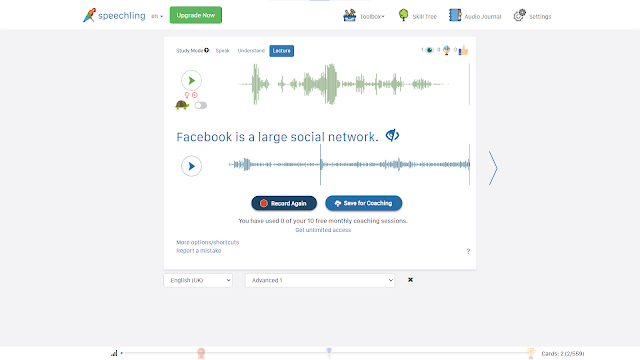Improve students' speaking skills with Speeching
Speaking English fluently has always been the dream for language learners. And it is evident that everyone eagers to freely talk about what they want to express and be well understood by others. However, students may find it hard to monitor and regulate progress in English speaking. So today I will introduce Speechling as a tool to help students start this journey and accelerate their speaking skills!
What is Speechling and how does it work?
Speechling is a nonprofit language learning platform that focuses on improving your speaking skills. Just like the parrot icon of the website, in Speechling, speaking practice is the simplest way of repetition and comparison. Students can gradually improve their fluency in a continuous circle of the four steps:
1. Listening-students can listen to how particular expressions and sentences are pronounced by a real native speaker instead of a machine.
2. Repeating- students repeat the expressions and imitate some speaking features (e.g. pronunciation, stress, tones, link sounds).
3. Reflecting- students listen to their voices that have been recorded on the app.
4. Comparing- students listen to the original pronunciation again to find what can be improved.
Also, students can get their personalised feedback from a tutor in an English speaking country. Just upload your recording and enjoy 10 times of this opportunity for free!
How does it relate to language learning?
Fluency does more than speaking in a natural and smooth flow, but the flow needs to be meaningful and effective in communication. Therefore, it is important that students can speak what they actually want to say and make others understand in different situations. In addition to repeating sentences, Speechling also provides three ways to enhance students' speaking skills by expressing their opinions and describing things.
In my future teaching, I believe 'describe the image' is an easy and interesting way to build up students' confidence in speaking. Take the picture below as an example, I can teach students some new words and expressions related to shopping (e.g. supermarket, check out, wait in a long queue) and they can use them as a scaffold to organise their thoughts in concrete sentences. This helps my students to be more precise and specific about what they are going to say so that others will not be confused.
Also, Speechling provides a phrasebook that can be used in many different circumstances. Students can learn sentences based on their practical needs such as booking a hotel and ordering food in a restaurant. This really suits those who learn English for travelling!
Limitations
1. Limited time for conversation practice
In the free version, students have only 10 seconds to organise their answers when doing the conversation practice, and 25 seconds in the paid version is still not enough in a real talking environment. I can understand there is a huge workload because the coach needs to listen to the records and give comments. Therefore, I believe it is necessary to build a speaking community where students from all over the world can engage in the process of practising and evaluating. And the time can be extended to around 1-2 minutes.
2. The phrase bank can be more structured
Another problem is that students can be overwhelmed by too many words and phrases at the same time, as the learning journey of some curriculums can be quite long and boring. Therefore, the app can classify various expressions into smaller parts with a more structured guideline.
Finally, here is a video for a detailed evaluation of Speechling. And don't forget to comment and share your thoughts!👀
Image source: screenshots from Speechling (click here)
Video source: YouTube (click here)









Comments
Post a Comment